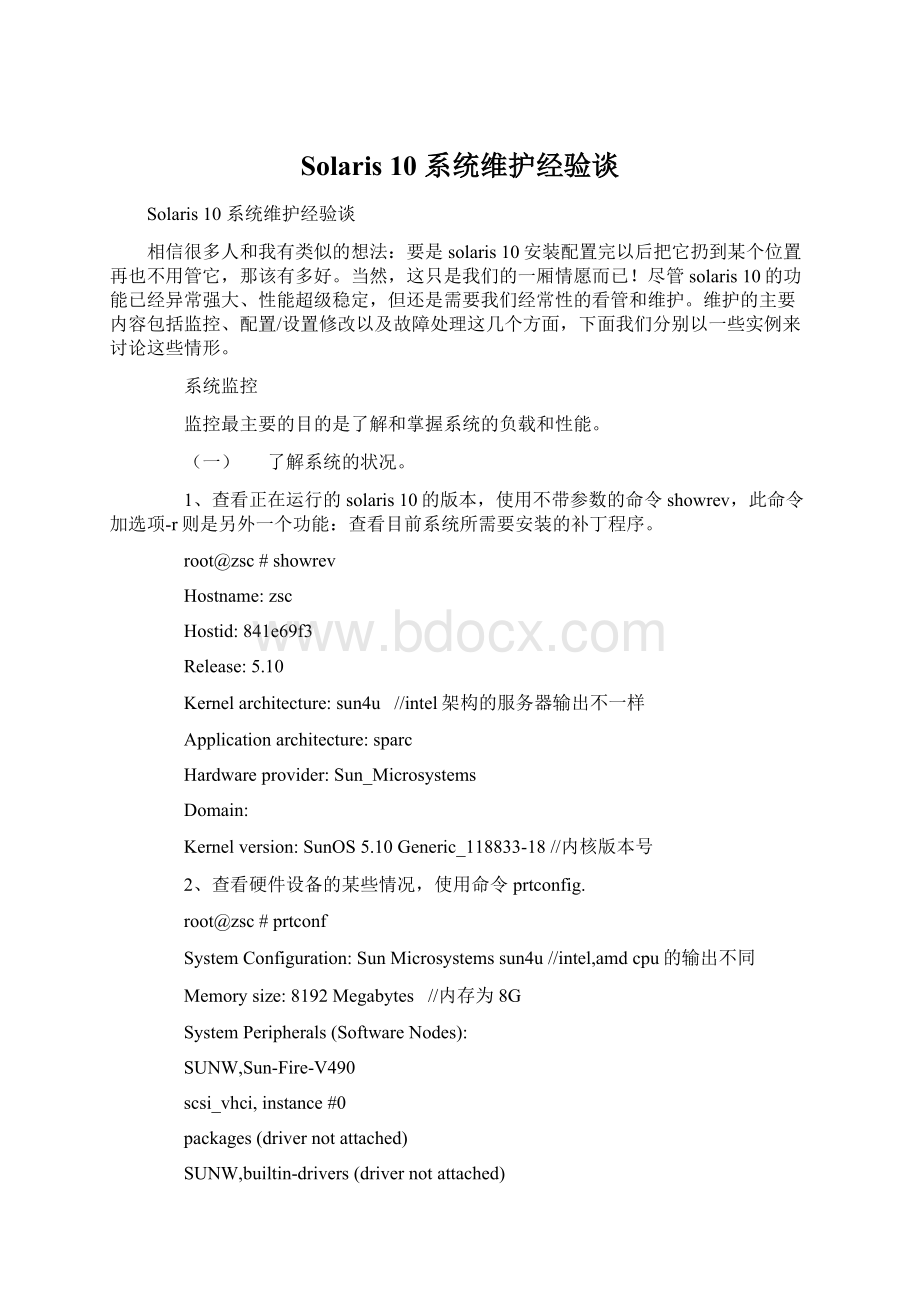Solaris 10 系统维护经验谈.docx
《Solaris 10 系统维护经验谈.docx》由会员分享,可在线阅读,更多相关《Solaris 10 系统维护经验谈.docx(11页珍藏版)》请在冰豆网上搜索。

Solaris10系统维护经验谈
Solaris10系统维护经验谈
相信很多人和我有类似的想法:
要是solaris10安装配置完以后把它扔到某个位置再也不用管它,那该有多好。
当然,这只是我们的一厢情愿而已!
尽管solaris10的功能已经异常强大、性能超级稳定,但还是需要我们经常性的看管和维护。
维护的主要内容包括监控、配置/设置修改以及故障处理这几个方面,下面我们分别以一些实例来讨论这些情形。
系统监控
监控最主要的目的是了解和掌握系统的负载和性能。
(一) 了解系统的状况。
1、查看正在运行的solaris10的版本,使用不带参数的命令showrev,此命令加选项-r则是另外一个功能:
查看目前系统所需要安装的补丁程序。
root@zsc#showrev
Hostname:
zsc
Hostid:
841e69f3
Release:
5.10
Kernelarchitecture:
sun4u //intel架构的服务器输出不一样
Applicationarchitecture:
sparc
Hardwareprovider:
Sun_Microsystems
Domain:
Kernelversion:
SunOS5.10Generic_118833-18//内核版本号
2、查看硬件设备的某些情况,使用命令prtconfig.
root@zsc#prtconf
SystemConfiguration:
SunMicrosystemssun4u//intel,amdcpu的输出不同
Memorysize:
8192Megabytes //内存为8G
SystemPeripherals(SoftwareNodes):
SUNW,Sun-Fire-V490
scsi_vhci,instance#0
packages(drivernotattached)
SUNW,builtin-drivers(drivernotattached)
………
3、查看本机所连接的磁盘数量,使用命令format.这个命令也是格式化硬盘的工具。
root@zsc#format
Searchingfordisks...done
AVAILABLEDISKSELECTIONS:
0.c1t0d0
/pci@9,600000/SUNW,qlc@2/fp@0,0/ssd@w21000014c39d4d9d,0
1.c1t1d0
/pci@9,600000/SUNW,qlc@2/fp@0,0/ssd@w21000014c39d4d9b,0
从输出可以知道此服务器有2个scsi硬盘。
4、查看网络接口的状况,使用带选项的命令ifconfig–a.
root@zsc#ifconfig-a
lo0:
flags=2001000849mtu8232index1
inet127.0.0.1netmaskff000000
ce0:
flags=1000843mtu1500index2
inet61.128.x.xnetmaskffffff00broadcast61.128.x.255
ether0:
14:
4f:
1e:
69:
f3//ce0是网络接口的名字
ce1:
flags=1000843mtu1500index3
inet192.168.x.5netmaskffffff00broadcast192.168.x.255
ether0:
14:
4f:
1e:
69:
f3//x是某个具体的数值,安全起见这样处理
从输出可知,本机有2个网络接口。
如果网络接口配置错误或没有激活,将有可能在输出中看不见接口名称及状态。
5、查看cpu的个数,使用不带参数的命令mpstat。
root@db890~#mpstat //这个命令也是查看CPU负载的工具
CPUminfmjfxcalintrithrcswicswmigrsmtxsrwsysclusrsyswtidl
0 0 1136 3 1 67 1 1 6 1 93 0 1 494
1 0 1101 25 22 67 1 1 6 1 85 0 1 495
2 0 1121 3 1 68 1 1 6 1 91 0 1 495
3 0 1129 3 1 69 1 1 6 1 95 0 1 495
4 0 1126 3 1 69 1 1 5 1 95 0 1 495
5 0 1125 129126 66 1 1 5 1 90 0 1 495
6 0 1123 4 1 68 1 1 6 1 92 0 1 495
7 0 1105 242140 65 1 1 7 1 89 0 0 495
从输出可知此服务器有8个cpu,此处按0-7的序号开始;有些输出不会以顺序序号开始,但可以从行数得知cpu数目(有多少行就有多少个cpu)。
(二)、用户及系统活动监控。
1、 查看系统运行了多少时间,使用不带参数的命令uptime
root@zsc#uptime
上午8点48分 运行4天15:
12,2用户,平均负载:
0.01,0.01,0.01
2、 查看有那些用户登录到solaris10系统,使用命令w.
root@zsc#w
上午9点12分 运行4天15:
36,3用户,平均负载:
0.02,0.01,0.01
用户名 终端号 登入时间 闲置 JCPU PCPU执行命令
root console 周一下午5点 5天 4:
53 4:
53/usr/dt/bin/dtscreen-modeblank
root pts/3 上午8点36分 25 -bash
root pts/4 上午9点12分 w
3、 查看系统的运行级别,使用带选项的命令who–r.
root@zsc#who-r
. run-level310月9日17:
36 3 0S
4、查看系统近期的运行状态(包括关机、重起、用户登录等),使用不带参数的命令last.
root@zsc#last|more
root pts/3 211.94.81.227 SatOct1414:
31仍在登录状态
root sshd 211.94.81.227 SatOct1414:
31仍在登录状态
root sshd 218.247.140.197SatSep1612:
03-12:
04(00:
00)
oracle console :
0 SatSep1612:
02-关机(00:
02)
reboot systemboot SatSep1612:
02
reboot systemdown SatSep1612:
01
root pts/4 61.128.122.128 SatSep1612:
01-关机(00:
01)
root sshd 61.128.122.128 SatSep1612:
01-关机(00:
01)
oracle console :
0 SatSep1612:
00-关机(00:
01)
reboot systemboot SatSep1611:
59
reboot systemdown SatSep1611:
59
oracle console :
0 SatSep1611:
58-关机(00:
01)
root console :
0 SatSep1611:
53-11:
54(00:
00)
oracle console :
0 SatSep1611:
52-11:
53(00:
01)
5、 查看系统运行的进程,通俗一点说就是查看系统正在运行那些程序,这是系统管理和维护过程中使用得最频繁的工具。
使用带若干选项的命令ps.ps-进程状态的缩写。
笔者常用的3个选项是:
-a列出请求最频繁的进程;-e列出正在运行的进程;-f打印进程的详细信息。
另外还有一个类似的工具ptree,用来查看进程树(提示:
linux里查看进程树的工具是pstree)。
root@zsc#ps-aef
UID PIDPPID C STIMETTY TIMECMD
root 0 0 010月09?
0:
10sched
root 1 0 010月09?
0:
02/sbin/init
root 2 0 010月09?
0:
00pageout
root 3 0 010月09?
46:
11fsflush
daemon 209 1 010月09?
0:
00/usr/lib/nfs/statd
root15302 315 014:
31:
04?
0:
00/usr/lib/ssh/sshd
oracle2917 1 010月10?
0:
06ora_smon_zsjdb
oracle6093 1 010月12?
0:
00ora_s041_zswdb
oracle5995 1 010月12?
0:
31ora_pmon_zswdb
oracle2915 1 010月10?
0:
11ora_ckpt_zsjdb
root@zsc#ptree
7 /lib/svc/bin/svc.startd
212 /usr/lib/saf/sac-t300
231 /usr/lib/saf/ttymon
219 /usr/lib/saf/ttymon-g-d/dev/console-lconsole-Tsun-mldterm,ttc
9 /lib/svc/bin/svc.configd
102 /usr/lib/sysevent/syseventd
103 /usr/sbin/nscd
113 /usr/lib/picl/picld
123 /usr/lib/crypto/kcfd
201 /usr/sbin/cron
2442/opt/oracle/product/9.2.0/bin/tnslsnrLISTENER-inherit
2909ora_pmon_zsjdb
2911ora_dbw0_zsjdb
2913ora_lgwr_zsjdb
有的时候,需要手动结束一个运行的进程,这种情况发生在诸如程序本身没有关闭指令等这样的场景。
结束进程使用kill或killall来完成。
执行结束进程的操作一定要仔细,看准确了再执行,不要杀错进程。
另外一个值得注意的是,不要随便赋予普通用户结束进程的权限,这是很冒险的事情。
6、 查看磁盘的使用情况也是一项十分重要的工作。
再大的磁盘空间也会随时间的推移而逐渐变小,当磁盘空间增加到一定限度的时候,有一些程序将发生错误甚至停止工作,我这里曾有一台监控服务器发送没有标题和内容的报警邮件,原因就是分区/tmp被文件填满而不能写入数据所致。
使用带参数的命令df–k或df–h来查看系统硬盘的容量使用情况,笔者本人倾向于使用参数–h(humanreadableformat)使其输出的格式更加人性化。
root@zsc#df-k
文件系统 千字节 用了 可用容量 挂接在
/dev/dsk/c1t0d0s0 1109369278869313095825 72% /
/devices 0 0 0 0% /devices
ctfs 0 0 0 0% /system/contract
proc 0 0 0 0% /proc
mnttab 0 0 0 0% /etc/mnttab
swap 2526104 10482525056 1% /etc/svc/volatile
objfs 0 0 0 0% /system/object
fd 0 0 0 0% /dev/fd
/dev/dsk/c1t0d0s5 605098215887924401681 27% /var
swap 2525376 3202525056 1% /tmp
swap 2525096 402525056 1% /var/run
/dev/dsk/c1t1d0s2 141179002 65553139701659 1% /opt/disk2
/dev/dsk/c2t40d0s6 2815892297006562271766775 3% /opt/data1
/dev/dsk/c2t40d1s6 281589229107661278665676 1% /opt/data2
/dev/dsk/c2t40d2s6 2815892292182197276591140 1% /opt/data3
root@zsc#df-h
文件系统 大小 用了 可用容量 挂接在
/dev/dsk/c1t0d0s0 11G 7.5G 3.0G 72% /
/devices 0K 0K 0K 0% /devices
ctfs 0K 0K 0K 0% /system/contract
proc 0K 0K 0K 0% /proc
mnttab 0K 0K 0K 0% /etc/mnttab
swap 2.4G 1.0M 2.4G 1% /etc/svc/volatile
objfs 0K 0K 0K 0% /system/object
fd 0K 0K 0K 0% /dev/fd
/dev/dsk/c1t0d0s5 5.8G 1.5G 4.2G 27% /var
swap 2.4G 320K 2.4G 1% /tmp
swap 2.4G 40K 2.4G 1% /var/run
/dev/dsk/c1t1d0s2 135G 64M 133G 1% /opt/disk2
/dev/dsk/c2t40d0s6 269G 6.7G 259G 3% /opt/data1
/dev/dsk/c2t40d1s6 269G 105M 266G 1% /opt/data2
/dev/dsk/c2t40d2s6 269G 2.1G 264G 1% /opt/data3
7、 查看网络连接,使用带选项的命令netstat.
root@zsc#netstat–anp//linux用这个选项将输出更多的信息,包括连接的进程等
NettoMediaTable:
IPv4
Device IPAddress Mask Flags PhysAddr
-------------------------------------------------------------
ce0 61.128.x.1 255.255.255.255 00:
00:
0c:
07:
ac:
7a
ce1 192.168.x.5 255.255.255.255SP 00:
14:
4f:
1e:
69:
f3
ce0 61.128.x.3 255.255.255.255 00:
0c:
31:
0b:
48:
8a
ce0 61.128.x.30 255.255.255.255 00:
14:
22:
0e:
f4:
c6
ce0 61.128.x.27 255.255.255.255 00:
14:
22:
b0:
94:
18
ce0 61.128.x.40 255.255.255.255SP 00:
14:
4f:
1e:
69:
f3
ce1 224.0.0.0 240.0.0.0 SM 01:
00:
5e:
00:
00:
00
ce0 224.0.0.0 240.0.0.0 SM 01:
00:
5e:
00:
00:
00
oot@zsc#netstat–r //查看路由表
RoutingTable:
IPv4
Destination Gateway FlagsRef Use Interface
-----------------------------------------------------------------
61.128.x.0 zsc U 1 239ce0
192.168.100.0 zsj U 1 4ce1
BASE-ADDRESS.MCAST.NETzsc U 1 0ce0
default 61.128.122.1 UG 1 2020
localhost localhost UH 26877301lo0
通过网络连接的状态,可以知道有哪些网络服务在工作,以及是否有非法的访问等情况。
8、查看系统用户近期执行了哪些操作,使用命令history。
切换到其他用户,看看最近他们都干了些什么。
(三)、负载监控
1、查看虚拟内存状态,使用带参数的命令vmstat。
root@zsc#vmstat44 //每4秒钟采集一次,采集4次
kthr memory page disk faults cpu
rbw swapfreeremfpipofrdesrs1sdsdsd in sy csussyid
0003999808228674479270000010129018620500100
00025256966370080 700000000128912520800100
00025256966370080 000000000129912619200100
0002525696637008192000000000130528321000100
可以通过输出值来判断某些性能下降或者故障产生的原因。
2、查看系统I/O,使用命令iostat.这个命令可以带很多选项,根据各自的需求选择选项。
root@zsc#iostat33//采集数据3次,每次3秒钟
tty sd1 ssd0 ssd1 ssd2 cpu
tintoutkpstpsservkpstpsservkpstpsservkpstpsserv ussywtid
0126 0 0 0 15 1 15 0 0 0 67 1 42 000100
0 79 0 0 0 0 0 0 0 0 0 8 1 15 00010